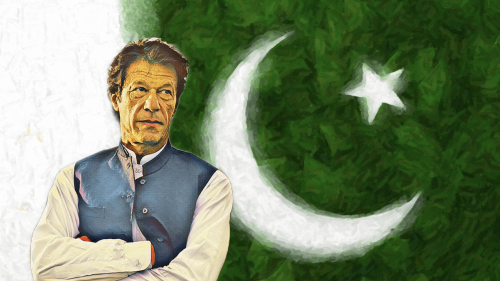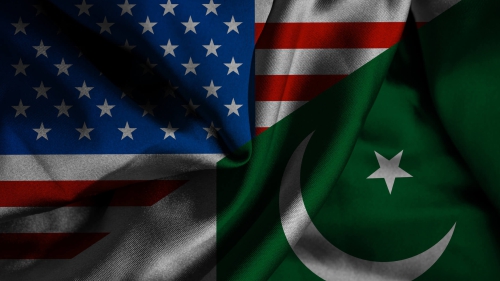Whither Kashmir Resistance Movement?
Few would disagree with the notion that nothing but the armed struggle took the Kashmir dispute to its present heights. Prior to 1988, Kashmir dispute was in a cold storage and now it is a focal point in global conflicts. Ironically, after 13 years of militant struggle, the armed struggle has started becoming a hurdle in progression towards the resolution of the Kashmir dispute. After December 13 attacks on Lok Sabha, India has not only been exerting pressure on Pakistan, but also has created war-like situation in the region. Succumbing to New Delhi's persistent demand and international pressure, Islamabad has started a crack down against Lashkar-e-Taiba and Jaish-e-Mohammad. Washington has already banned both the organizations besides assuring India all support in its battle against terrorism.
Massive Indian build-up on forward positions along its 2912-km border with Pakistan, coupled with belligerent statements by Atal Bihari Vajpayee, has already resulted in heightening of tension to alarming levels where war seems just around the corner. The recent building up of tension not only puts Kashmir into limelight, but also initiated guessing game about the future of armed struggle in Kashmir. Many observers' caution that the time for count down against armed struggle has come.
India very skillfully divided armed struggle into two parts. They completely ignored indigenous militancy and made the Pakistan-based organizations a contentious issue with Pakistan. In present international atmosphere against terrorism, New Delhi tactfully focused on the Lashkar and Jaish-e-Mohammad instead of local organizations, knowing the fact that these could be the easy preys. While both the countries are in the phase of discarding old friends and searching for the new ones, it is another opportunity to examine as to what went wrong with the Kashmir issue, and why a legitimate resistance movement has to face such tough challenges.
Undoubtedly, Kashmiris started their struggle on their own and sustained it till 1993 with an objective to bring the Kashmir dispute in the international limelight. Moreover, they mobilized the local population against Indian occupation and created resistance culture in Jammu and Kashmir. Within a few months, they managed to get all their objectives and earned open support from everywhere. The movement also earned attention for human rights organizations and international media, which duly noticed the Indian atrocities and illegal occupation.
Non-Kashmiri elements in the independence movements are obviously the late entrants. Harkat-ul-Ansar, formed in 1993, was the first organization to join the resistance movement in Kashmir. Lashkar and Jaish-e-Mohammad followed the suit in later years. Common Kashmiris termed them as 'guest Mujahideen' and respected their motivation and commitment for the Kashmir cause.
Unfortunately, July of 1995 introduced to the world an unknown militant outfit Al-Faran that the Indians claimed to have kidnapped some western tourists and sought release of around 17 prisoners including Maulana Azhar Masood. New Delhi alleged Harkat of being involved in the kidnapping of foreign tourists. It was then India pronounced that Pakistan was providing clandestine aid to Harkat. India used the incident the world over to paint the Kashmir resistance movement as sheer terrorism. Despite rejection of Indian claims regarding the kidnapping, the outside world stood by the Indian version of the story. No evidence was provided to the world media in this regard. Perhaps none was there with New Delhi to substantiate the claims. The July 1995 kidnapping of tourist proved real blow for the Kashmir movement coupled with constant killings of minorities in the occupied valley.
The killings of non-Muslims were alleged by New Delhi as an act carried out by the non-Kashmiris groups. Once again the western world did not disappoint India by not subscribing its point of view. It was then that New Delhi recognized the usefulness of non-Kashmiri groups as a tool to malign the whole movement. As per a tactful move, the Indian media left no stone unturned in censuring non-Kashmiri outfits. Ignoring the role of local Kashmiri outfits in armed struggle and hiding their activities, India deliberately glorified Pakistan-based groups.
While India tactfully used non-Kashmir groups card, the Pakistani establishment did not bother to review its approach towards Pakistan-based organizations. The morale and valour of these Pakistan-based outfits impressed a group of official in Islamabad and Rawalpindi. Especially after Kargil war in 1999, Lashkar continued to send shock waves through its most dreaded fidayeen attacks. Home Minister LK Advani told the Lok Sabha recently that the number of fidayeen attacks in Jammu and Kashmir exceeded the mark of one hundred, 35 of which were attributed to Lashkar alone. These attacks may not have inflicted massive casualties (officially Indian authorities confirmed Killing of its 143 Armed persons) on the Indian forces, but their psychological impact was enough to change the whole scene of the independence struggle. Some 3,000 people scarified their lives, 130 people were put in Indian jails, and still around 1,000 are operating on the Indian slice of Jammu and Kashmir. More importantly, they were more dependent on Pak based organizations than politically activated Kashmiris. All these factors fascinated the Pakistani establishment for creating non-Kashmiri outfits. They found these groups merited for increased aid. The Pakistani establishment badly failed to foresee the possible impact this unnecessary support to these groups on the overall posture of the movement. In fact they could not assess the international mood and pressures regarding 'cross border terrorism'. During his brief visit to Islamabad, former American president Bill Clinton categorically said, "Borders cannot be altered through violence."
Many sane intellectuals and Kashmir watchers had been advising these outfits to join the indigenous organizations to avoid further point scoring by Indians in the name of non-Kashmiri groups. The over-ambitious militants refused to submerge their groups into the mainstream freedom fighter organizations. Despite their tremendous sacrifices, the world got the wrong message and provided the Indians with an excuse to term the indigenous uprising as a foreign sponsored movement.
The intelligent sympathizers of the movement suggested these groups to work in a low profile and 'Kashmirise' their leadership cadre to divert the Indian media onslaught. The youthful 'mujahideen' turned a deaf ear to the idea and continued to unknowingly spoil the image of the whole movement. However, following the development of post September 11 situation generally and December 13 Lok Sabha attacks, the same people re-located their offices as well as leadership slots for Kashmiris. Their all-out support for Taliban against coalition forces did become another reason for their fateful end.
The other mistake they made was opening of too many fronts at the same time without keeping in mind the principles of real politick. They used to criticize and threaten foreign allies of India, which mainly included western power like United States and United Kingdom. Such outspoken remarks made front-page stories in leading regional newspapers, both in English and Urdu. Indian media and the establishment were dying to project such statements, which carried poison against foreign countries. Indian radio and television analysts who were equally joined by the BBC South Asia reports discussed such remarks at length and drew horrifying scenarios to scare the American and British people of these groups extremism.
British writer and south Asian expert Victoria Schofield commented on the situation in a very pertinent way in her recent work titled Kashmir in Conflict,. "The Hizbul Mujahideen was still regarded as the group which had the most indigenous support. For this reason, the Indian government noticeably downplayed its activities compared with those of the Harkat or Lashkar-i-Taiba, which were believed to have many more 'foreign' adherents," wrote Ms Schofield.
Kashmiri political leadership and media got the wind before present debacle and tried to divert it. In November, All Parties Hurriyat Conference (APHC) Chairman Professor Abdul Gani Bhat flanked by Mir Waiz Omar Farooq, Maulana Abbas Ansari, Ali Mohammad Mir, representative of Jamaat-i-Islami and JKLF Acting Chairman Bashir Ahmed Bhat, proposed a three-point formula in Srinagar to resolve the longstanding Kashmir issue. He suggested that India, Pakistan and Mujahideen should announce comprehensive cease-fire. A result-oriented dialogue involving the governments of Pakistan and India, and the 'genuine representatives' of the people of the state should follow truce, they demanded. The Kashmiri leadership also sought resolution of the dispute within a timeframe and suggested that a solution should be acceptable, honorable and durable.
The APHC leaders' move was in line with the current international political atmosphere. Many world leaders indicated that Kashmir resistance would not get any special treatment. In this background, a major shift in APHC polices was imminent and understandable. APHC leaders believe that in new global situation, focus should be on political struggle rather than the armed one. Ironically, neither India nor any body else listened to them.
Given the current military build-up apparently as a result of December 13 attacks on Lok Sabha, US and British silence in support for Pakistan and subscription to Indian version of terrorism in the occupied state, following trends could be visible in the near future:
The Lashkar-i-Taiba and Jaish, though both have denied any involvement in the US attacks, would be brought to task for their expression of solidarity with the Taliban and alleged terrorism in India;
The international observers will examine the recent phase of so-called suicide bombings in Kashmir and civilian targeting more closely, and parallels would be drawn with known terrorist movements in the rest of the world.
The military regime in Pakistan will have to reverse or reassess its approach towards the armed resistance in the occupied Kashmir without annoying Islamist political parties, which have formed an alliance for the forthcoming elections. The military government, though, has the muscle as well as the necessary foreign support to re-orient its position on the issue. There is no denying that the current military regime is quite liberal in its religious outlook, which is why Washington and London have not openly criticized it so far.
Islamabad should benefit from the current visit by British Prime Minister Tony Blair in pursuing India to take steps like allowing foreign media in the J&K, elimination of custodial killings, reduction of troops besides releasing the political prisoners. Such confidence building would not only promote political elements in the valley but also encourage Pakistan to take bold steps in future. However, Britain as well as the western world must realize that the political situation can only be improved if India takes some concrete steps to improve human rights situation in its occupied part of the state. Last but not the least, such steps would only pave the way for favorable environment for free thinking amongst the Kashmiri people. The real solution, by all means, lies in the structuring of a package or formula, which could either lead to the implementation of UN resolutions or an alternative road map to resolution of the dispute according to the wishes of the Kashmiri people.
(The writer is a specialist on Kashmir conflict and a fellow with the Institute of Policy Studies Islamabad. He recently visited New Delhi and the Indian occupied Jammu and Kashmir)

















